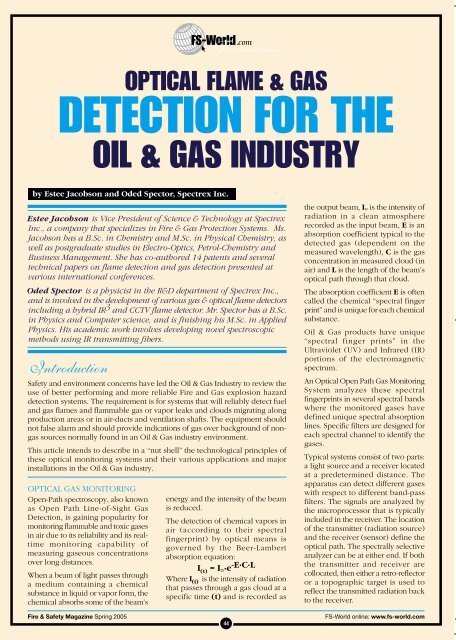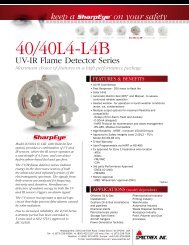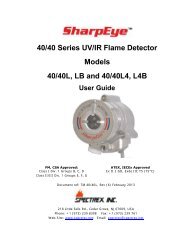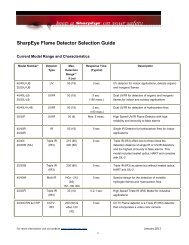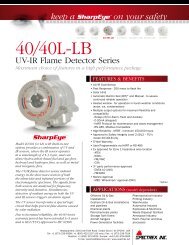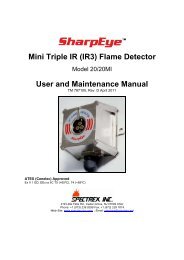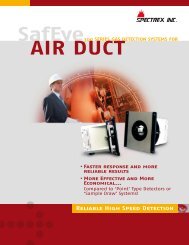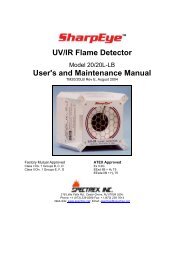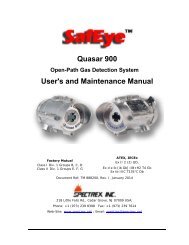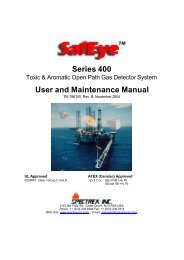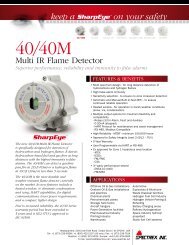DETECTION FOR THE - Spectrex Inc.
DETECTION FOR THE - Spectrex Inc.
DETECTION FOR THE - Spectrex Inc.
Create successful ePaper yourself
Turn your PDF publications into a flip-book with our unique Google optimized e-Paper software.
FS-World.com<br />
8 ire & Safety Magazine<br />
F<br />
OPTICAL FLAME & GAS<br />
<strong>DETECTION</strong> <strong>FOR</strong> <strong>THE</strong><br />
OIL & GAS INDUSTRY<br />
by Estee Jacobson and Oded Spector, <strong>Spectrex</strong> <strong>Inc</strong>.<br />
Estee Jacobson is Vice President of Science & Technology at <strong>Spectrex</strong><br />
<strong>Inc</strong>., a company that specializes in Fire & Gas Protection Systems. Ms.<br />
Jacobson has a B.Sc. in Chemistry and M.Sc. in Physical Chemistry, as<br />
well as postgraduate studies in Electro-Optics, Petrol-Chemistry and<br />
Business Management. She has co-authored 14 patents and several<br />
technical papers on flame detection and gas detection presented at<br />
various international conferences.<br />
Oded Spector is a physicist in the R&D department of <strong>Spectrex</strong> <strong>Inc</strong>.,<br />
and is involved in the development of various gas & optical flame detectors<br />
including a hybrid IR 3 and CCTV flame detector. Mr. Spector has a B.Sc.<br />
in Physics and Computer science, and is finishing his M.Sc. in Applied<br />
Physics. His academic work involves developing novel spectroscopic<br />
methods using IR transmitting fibers.<br />
Introduction<br />
Safety and environment concerns have led the Oil & Gas Industry to review the<br />
use of better performing and more reliable Fire and Gas explosion hazard<br />
detection systems. The requirement is for systems that will reliably detect fuel<br />
and gas flames and flammable gas or vapor leaks and clouds migrating along<br />
production areas or in air-ducts and ventilation shafts. The equipment should<br />
not false alarm and should provide indications of gas over background of nongas<br />
sources normally found in an Oil & Gas industry environment.<br />
This article intends to describe in a “nut shell” the technological principles of<br />
these optical monitoring systems and their various applications and major<br />
installations in the Oil & Gas industry.<br />
OPTICAL GAS MONITORING<br />
Open-Path spectroscopy, also known<br />
as Open Path Line-of-Sight Gas<br />
Detection, is gaining popularity for<br />
monitoring flammable and toxic gases<br />
in air due to its reliability and its realtime<br />
monitoring capability of<br />
measuring gaseous concentrations<br />
over long distances.<br />
When a beam of light passes through<br />
a medium containing a chemical<br />
substance in liquid or vapor form, the<br />
chemical absorbs some of the beam’s<br />
energy and the intensity of the beam<br />
is reduced.<br />
The detection of chemical vapors in<br />
air (according to their spectral<br />
fingerprint) by optical means is<br />
governed by the Beer-Lambert<br />
absorption equation:<br />
I (t) = I .e -E .C.L<br />
°<br />
Where I (t) is the intensity of radiation<br />
that passes through a gas cloud at a<br />
specific time (t) and is recorded as<br />
the output beam, I °<br />
is the intensity of<br />
radiation in a clean atmosphere<br />
recorded as the input beam, E is an<br />
absorption coefficient typical to the<br />
detected gas (dependent on the<br />
measured wavelength), C is the gas<br />
concentration in measured cloud (in<br />
air) and L is the length of the beam’s<br />
optical path through that cloud.<br />
The absorption coefficient E is often<br />
called the chemical “spectral finger<br />
print” and is unique for each chemical<br />
substance.<br />
Oil & Gas products have unique<br />
“spectral finger prints” in the<br />
Ultraviolet (UV) and Infrared (IR)<br />
portions of the electromagnetic<br />
spectrum.<br />
An Optical Open Path Gas Monitoring<br />
System analyzes these spectral<br />
fingerprints in several spectral bands<br />
where the monitored gases have<br />
defined unique spectral absorption<br />
lines. Specific filters are designed for<br />
each spectral channel to identify the<br />
gases.<br />
Typical systems consist of two parts:<br />
a light source and a receiver located<br />
at a predetermined distance. The<br />
apparatus can detect different gases<br />
with respect to different band-pass<br />
filters. The signals are analyzed by<br />
the microprocessor that is typically<br />
included in the receiver. The location<br />
of the transmitter (radiation source)<br />
and the receiver (sensor) define the<br />
optical path. The spectrally selective<br />
analyzer can be at either end. If both<br />
the transmitter and receiver are<br />
collocated, then either a retro-reflector<br />
or a topographic target is used to<br />
reflect the transmitted radiation back<br />
to the receiver.<br />
Fire & Safety Magazine Spring 2005<br />
44<br />
FS-World online: www.fs-world.com
FS-World.com<br />
8 ire & Safety Magazine<br />
F<br />
Gas detection in petrochemical<br />
production areas is aimed at explosion<br />
threats. Not all gas clouds are<br />
hazardous. If a flammable cloud<br />
plume is wide enough to allow flame<br />
acceleration up to speeds greater than<br />
100m/sec. (about 200 mph), it then<br />
becomes a significant threat. A flame<br />
front needs distance to reach a<br />
velocity, which causes the damaging<br />
effects of over-pressure. The<br />
confinement and congestion of the<br />
area mainly control this distance.<br />
In typical offshore industries, a<br />
5-meter diameter (about 15 feet) gas<br />
cloud can be considered a major<br />
threat since it can develop an<br />
explosion at a low concentration of<br />
gas in air. Traditionally, installing a<br />
grid of many “point” type detectors<br />
in a three-dimensional grid formation<br />
and correlating their signals achieved<br />
gas cloud monitoring. One detector<br />
upon seeing gas should cause a<br />
warning while a second one would<br />
cause automatic actions. However,<br />
plumes of significant leaks passed<br />
undetected between monitoring<br />
positions.<br />
Reliability and safety being the most<br />
important issues when measuring and<br />
monitoring combustible or toxic<br />
gases, the following performance<br />
criteria must be addressed by the<br />
system:<br />
• Real time measurement (an active<br />
system) over a predetermined<br />
transmitter receiver path length.<br />
• Automatic self-calibration to<br />
minimize false alarms.<br />
• Continuously working through<br />
significant interferences, such as<br />
humidity, rain, fog, snow, and<br />
background radiation (sun, lamps,<br />
heaters, etc.).<br />
• Capability to monitor various gas<br />
concentrations from traces to<br />
potentially explosive levels (PPM<br />
to LEL).<br />
• Immunity to any chemical reaction<br />
with hazardous gas environment.<br />
• Simultaneous detection of<br />
homologue hydrocarbons series<br />
(C1 - C8) with one instrument.<br />
• Completely immune to industrial<br />
and environmental radiation<br />
sources.<br />
• Easily adapted for field usage,<br />
simple installation.<br />
OPEN PATH GAS <strong>DETECTION</strong><br />
TECHNOLOGY<br />
Today, when novel techniques of<br />
electro-optical monitoring include<br />
smart sensors with specific optical<br />
filters and algorithms managed by<br />
microprocessors that analyze the<br />
absorption signal of a gas component<br />
within the cluttered signal of changing<br />
environment absorption, the openpath<br />
remote sensing (beam-sensors)<br />
technology has acquired recognition.<br />
The described open path gas<br />
detection system consists of two<br />
modules (Figure 1):<br />
1. Light source – a unique flash light<br />
source, which can be activated at<br />
various frequencies and which<br />
emits pulses of light with a wide<br />
spectral band (UV to IR).<br />
2.Detector – the sensing and<br />
analyzing module of the system,<br />
which contains several sensors with<br />
unique filters.<br />
The light source and detector are<br />
mounted and aligned at a<br />
predetermined distance (fixed in a<br />
given installation). The optical path,<br />
which is monitored, is the direct line<br />
of sight between them. Since the<br />
distance between light source and<br />
detector is different from one<br />
installation to the next, the gas<br />
concentration is measured in LELxM<br />
(Lower Explosion Limit concentration<br />
meter). To obtain the average gas<br />
concentration over the optical path,<br />
The ppm x meter concept<br />
Line Detector<br />
10 ppm<br />
200 ppm<br />
100 m.<br />
Gas Cloud<br />
20 m.<br />
1 m.<br />
the LELxM concentration is divided<br />
by the distance between light source<br />
and detector (in meters).<br />
The light source that can be activated<br />
at various frequencies emits very short<br />
(microseconds long) pulses of light<br />
enabling the recognition of its unique<br />
pattern by the receiver which<br />
distinguishes it from background<br />
radiation sources such as sunlight,<br />
filament lamps, projectors, heat<br />
generators, etc. The receiver contains<br />
several sensors according to the<br />
specific gases (or chemical families)<br />
to be detected.<br />
The signal and reference band-pass<br />
filters are centered in the 2-5 microns<br />
IR band or in the 0.2-0.3 microns UV<br />
band type according to the detected<br />
gases strongest spectral absorption.<br />
Line Detector<br />
Detector output = (gas cloud length) x (gas cloud concentration)<br />
Figure 1: The ppm x meter concept<br />
Fire & Safety Magazine Spring 2005<br />
45<br />
FS-World online: www.fs-world.com
FS-World.com<br />
8 ire & Safety Magazine<br />
F<br />
With its unique (patented) flashing<br />
light source, the state-of-the-art gas<br />
detector, which has been adopted<br />
and specified by the leading Oil &<br />
Gas companies, is fully immune to<br />
false alarms caused by background<br />
radiation sources. Additionally, this<br />
type of gas detector does not interfere<br />
with other optical detectors to cause<br />
undesirable false alarms as a result of<br />
its operation.<br />
These systems can function<br />
effectively, even under extreme<br />
environmental interference such as<br />
fog, rain, smog, etc., must set off a<br />
warning signal for malfunction when<br />
such an interference completely<br />
blocks the system’s line of sight, and<br />
it is no longer able to provide accurate<br />
detection.<br />
These systems have specific UV<br />
models for detection of toxic gases<br />
such as Hydrogen Sulfide (H 2<br />
S) and<br />
Ammonia (NH 3<br />
). These gases have<br />
unique UV spectral "fingerprints" in<br />
the 189-225nm (H 2<br />
S) and 195-215nm<br />
(NH 3<br />
) bands, enabling their detection<br />
at sensitivities lower than 50ppm.m.<br />
Tests performed on various<br />
concentrations of NH 3<br />
and H 2<br />
S have<br />
shown a linear response by the system<br />
to these gases.<br />
Unique models have been developed<br />
for specific applications such as the<br />
short distance “Air Duct “ monitoring<br />
systems.<br />
Air Duct Installation at Akzo Chemical Plant<br />
Air Duct Installation on ETAP Platform in the North Sea<br />
AIR DUCT MONITORING<br />
SYSTEM<br />
Continuous monitoring of the toxic<br />
and flammable vapors and gases<br />
present in air ducts is mandatory for<br />
determining their concentrations<br />
accurately in order to notify personnel<br />
of a potential hazard, thus enabling<br />
them to take the adequate measures.<br />
The Duct Open Path gas detector was<br />
designed specially to monitor the<br />
build-up of dangerous gaseous<br />
concentrations in HVAC air ducts in<br />
turbine air intakes in chemical<br />
processes and in ventilation ducts.<br />
The system withstands harsh<br />
environmental conditions (extreme<br />
temperatures and high airflow), and<br />
requires simple installation, alignment<br />
and calibration with no need for<br />
periodical calibration or special<br />
maintenance.<br />
MULTIPURPOSE GAS<br />
MONITORING SYSTEMS<br />
A major growth of the use of Open<br />
Path systems is in oil and gas offshore<br />
production platforms, floating<br />
production shipping and offloading<br />
vessels (FPSOs), and onshore<br />
production and storage facilities.<br />
Typical application areas include:<br />
• Chemical processes involving<br />
gaseous compositions<br />
• Distillation and refining processes<br />
• Desulfurization process (H 2<br />
S)<br />
• Air ducts and air-intakes monitoring<br />
• Pipelines (compressor stations)<br />
• Turbines enclosures<br />
• Stack Burners (emission<br />
monitoring)<br />
Some examples of these unique<br />
applications of the Open Path Gas<br />
Monitoring in the Oil & Gas industry<br />
are listed below:<br />
"BANFF" Floating Production<br />
Vessel (FPSO), North Sea, (UK)<br />
The Banff field lies 25km south east<br />
of the Gannet accumulations in the<br />
Central North Sea, 200 km east of<br />
Aberdeen.<br />
A new Floating Production, Storage<br />
and Offloading (FPSO) system owned<br />
and operated by Petroleum Geo-<br />
Services UK Limited (PGS) develop<br />
Banff on the Conoco oil field in the<br />
North Sea.<br />
The Fire & Gas protection equipment<br />
includes: 40 SafEye Flash (IR) Gas<br />
Detectors, Model 203 (33-131ft/10-<br />
40m), 24 SafEye Lamp (IR) Model 301<br />
(2-11.5ft/0.6-3.5m), 15 SafEye Flash<br />
(IR) Model 202 (10-39ft/3-12m) and<br />
50 SharpEye Triple IR (IR3) Model<br />
20/20I Flame Detectors.<br />
Curlew FPSO<br />
The Curlew FPSO, operated by<br />
AMEC for Shell Exploration, is located<br />
in the Central North Sea, 210km east<br />
of Aberdeen. Like other modern<br />
offshore production facilities, the<br />
FPSO is protected by 45 SafEye Lineof-Sight<br />
Gas Detection Systems.<br />
Fire & Safety Magazine Spring 2005<br />
46<br />
FS-World online: www.fs-world.com
FS-World.com<br />
8 ire & Safety Magazine<br />
F<br />
Petrojarl IV Foinhaven FPSO<br />
The Petrojarl IV Foinaven ship is<br />
operated by BP in the West of<br />
Shetland field in the North Sea. Oil is<br />
stored in the ship's double-hulled<br />
tanks and is offloaded every three to<br />
four days to dedicated shuttle tankers.<br />
Siemens installed the complete fire<br />
and gas detection system including<br />
230 SharpEye IR3 Flame Detectors<br />
with communication by means of RS-<br />
485 databus (Profibus) loops between<br />
the detectors and control central<br />
computer.<br />
Schiehallion<br />
Schiehallion exploration field in the<br />
deep waters of the Shetland Trough<br />
in the NW Atlantic is operated mainly<br />
by British Petroleum (BP) in<br />
cooperation with six other oil<br />
companies. The Schiehallion FPSO is<br />
capable of storing 950,000 barrels of<br />
oil.<br />
The production vessel is monitored<br />
by over 130 SafEye systems covering<br />
distances from 130 meters (430ft) to<br />
half a meter (1.5ft) path, and<br />
protecting areas such as ducts,<br />
turbines, intakes and exhaust, as well<br />
as various production sites.<br />
Terra Nova – Largest-ever<br />
Offshore Oil Production Project<br />
in Canada<br />
Terra Nova, Eastern Canada’s second<br />
largest oil field, is located on the<br />
Grand Banks 350 km east-southeast<br />
of St. John's, Newfoundland, and 35<br />
km SE of Hibernia, in 95m of water.<br />
Two types of SafEye units were<br />
installed in this project:<br />
1)SafEye Model 204 Flash Type IR for<br />
hazardous outside locations on the<br />
deck and the hull of the FPSO, and<br />
2)SafEye Model 301/302 IR Duct units<br />
used to monitor airflow for<br />
flammable gases inside duct air<br />
intakes.<br />
"TRITON" Floating Production<br />
Shipping Offloading Vessel<br />
(FPSO), North Sea (UK)<br />
On "TRITON" FPSO, owned by<br />
Shell/Amerada Hess, reservoir fluids<br />
are processed to enable stabilized<br />
crude oil to be exported by tankers.<br />
Gas is exported and used as fuel on<br />
the FPSO. Honeywell Control Systems<br />
(UK) installed the fire and gas<br />
protection systems that included the<br />
<strong>Spectrex</strong> line of products:<br />
• 14 SafEye IR Flash Type Model 202<br />
(3-12m/10-39ft)<br />
• 25 SafEye Open Path Gas Detector<br />
and IR Flash Type Model 203 (10-<br />
40m/33-131ft)<br />
• SafEye IR Lamp Type Model 304<br />
(0.6-3.5m/2-11.5ft) (Duct Application)<br />
Alyeska Pipeline<br />
Alyeska's 800-mile pipeline from<br />
Prudhoe Bay to Valdez, the famous<br />
trans-Alaska pipeline, is a major<br />
project, which includes the mainline,<br />
pump stations and the Valdez Marine<br />
Terminal.<br />
The first batch of SafEye Open Path<br />
Gas Detection systems has been<br />
supplied to protect compressor<br />
stations.<br />
Kazakhstan Pipeline<br />
Nuovo Pignone from Firenze (Italy)<br />
installed 12 SafEye Open Path (Lineof-Sight)<br />
IR (OPIR) Gas Detection<br />
Systems in the Kazakhstan pipeline<br />
project. The systems protect the Turbo<br />
gas station and monitor hydrocarbon<br />
leaks.<br />
BREVIK, Norway: Chemical Waste<br />
Treatment Plant<br />
NOAH (Norwegian Government<br />
Waste Material Agency) site processes<br />
the waste, which is mostly petroleum<br />
based and is delivered to the site in<br />
steel drums; these drums are stored<br />
in a large warehouse before they are<br />
processed.<br />
ABB Offshore Technology and<br />
Wormald Signalco A/S designed and<br />
installed the fire and gas protection<br />
systems that include:<br />
Fire & Safety Magazine Spring 2005<br />
47<br />
FS-World online: www.fs-world.com
Storage and Process Areas - 48<br />
SharpEye Triple IR (IR3) Model 20/20I<br />
Flame Detectors<br />
Chemical Waste Sampling Area - 2<br />
SafEye Open Path Lamp IR Gas<br />
Detectors, Model 312 (23-98m) 7-30ft<br />
Storage Area - 2 SafEye Flash IR,<br />
Model 224 (25-80m) 82-262ft<br />
ENICHEM Chemical Plant,<br />
Ravenna, Italy<br />
SafEye Open Path IR (OPIR) Gas<br />
Detection Systems are installed at<br />
ENICHEM Chemical Plant in Ravenna<br />
(Italy) that processes Butadiene-<br />
Butane. The systems are protecting<br />
the railway loading platforms.<br />
Bruce Platform (BP, UK)<br />
BP Amoco, Elf, Total, BHP and VEBA<br />
are operating the Bruce field complex<br />
that consists of three platforms and<br />
one sub sea manifold. Oil and gas<br />
from the Bruce Reservoir are<br />
recovered by 15 platform wells and<br />
5 sub sea wells. A second<br />
development phase, Bruce 2, was<br />
started in 1995.<br />
ICS installed <strong>Spectrex</strong> SafEye Gas<br />
Detection Systems on Bruce 2<br />
platform.<br />
ETAP<br />
(Eastern Trough Area Project)<br />
The ETAP (Eastern Trough Area<br />
Project), North Sea (Britain), is one<br />
of the world's most modern, and<br />
largest offshore oil production<br />
platform areas. It was built by AMEC<br />
for British Petroleum Exploration with<br />
Esso, BHP, AGIP, and Shell as partners<br />
that combined their efforts in order<br />
to explore this field. This project is<br />
protected by 135 SharpEye Triple IR<br />
(IR3) Flame Detectors and 110 SafEye<br />
Open Path Gas Detection Systems<br />
(including approximately 20 systems<br />
to protect air intakes to turbines and<br />
air ducts).<br />
Malory and Laps Platforms<br />
Mobil's 60bcf Malory offshore<br />
platform development, 15 km<br />
southwest of Shell's Barque Field. Gas<br />
is piped through a new 8 km line into<br />
Mobil's LAPS Transportation System<br />
to the Bacton terminal.<br />
Fire & Safety Magazine Spring 2005<br />
FS-World.com<br />
8 ire & Safety Magazine<br />
F<br />
Both the Malory platform and the<br />
Laps transportation system are<br />
protected by SafEye systems.<br />
OSEBERG, Norway -<br />
Two Norwegian Offshore<br />
Platforms<br />
OSEBERG offshore platform is owned<br />
by Norske-Hydro, Mobil, Statoil, Saga<br />
and Conoco. Located about 130<br />
kilometers northwest of Bergen,<br />
Oseberg has been developed with a<br />
total of three platforms. Oseberg A<br />
and B stand at the southern end of<br />
the field and are linked by a 100-<br />
meter bridge. They form the Oseberg<br />
field center. The C platform lies 14<br />
kilometers to the north.<br />
The platforms are protected as<br />
follows:<br />
Oseberg North:<br />
19 SafEye Detectors, IR Flash Model<br />
Series 200<br />
Oseberg South:<br />
42 SafEye Detectors, IR Flash Model<br />
Series 200<br />
5 SafEye Detectors, IR Lamp Model<br />
301<br />
South Arne Platform,<br />
North Sea<br />
Amerada Hess' North Sea field, South<br />
Arne (SA), is being developed with<br />
horizontal wells and multiple<br />
hydraulic propped fractures. The<br />
South Arne field is located in the<br />
48<br />
northern part of the Danish sector of<br />
the North Sea.<br />
The offshore platform is protected by<br />
28 SafEye Systems.<br />
Thistle Platform –<br />
Northeast of the Shetland Islands<br />
Thistle ‘A’, operated by BP, is 13<br />
kilometers from the Dunlin platform,<br />
which in turn is linked to Cormorant.<br />
Brown & Root installed <strong>Spectrex</strong><br />
SafEye Open Path Gas Detection<br />
Systems to protect the platform.<br />
Vigdis Platform, North Sea<br />
Vigdis Platform is located in the oil<br />
field between Snorre and Gulfaks<br />
fields in the North Sea. Its installations<br />
are tied back to the Snorre platform<br />
where the petroleum is processed.<br />
The crude oil is transferred via<br />
dedicated pipelines to Gulfaks A for<br />
storage and loading into tankers.<br />
Autronica Offshore installed <strong>Spectrex</strong><br />
SharpEye flame detectors and SafEye<br />
Open Path Gas Detectors to protect<br />
the platform production areas.<br />
Shell Petrochemical Plant,<br />
Moerdijk, The Netherlands<br />
Shell Oil Company and BASF have<br />
put in place a joint venture for the<br />
construction of a world-scale styrene<br />
monomer/propylene oxide plant at<br />
Moerdijk, The Netherlands.<br />
The Dutch engineering company ABB<br />
Lummus global and the gas contractor<br />
FS-World online: www.fs-world.com
FS-World.com<br />
8 ire & Safety Magazine<br />
F<br />
Figure 2: Radiation of a Typical Hydrocarbon Flame<br />
MSA (The Netherlands branch)<br />
installed SafEye Open Path Gas<br />
Detection Systems as follows:<br />
For the original plant - 8 SafEye Flash<br />
(IR) Systems Model 225 for perimeter<br />
(fence) detection.<br />
For the new plant (MSPO 2) - 30<br />
SafEye Flash (IR) Systems Model 200.<br />
In the first phase of the retrofit<br />
program of the original plant - 30<br />
SafEye Flash (IR) Systems Model 200.<br />
Wytch Farm<br />
Wytch Farm oil field is comprised of<br />
three separate oil reservoirs that lie<br />
under Poole Harbor and Poole Bay<br />
in Dorset with a total number of 29<br />
injection and 74 producing wells.<br />
Wytch Farm Storage Terminal is<br />
protected by <strong>Spectrex</strong> SafEye Gas<br />
Detection Systems.<br />
OPTICAL FLAME <strong>DETECTION</strong><br />
Optical flame detection is based on<br />
detecting the unique characteristics<br />
of the electromagnetic energy emitted<br />
by a fire, including its spectral<br />
signature and frequency pattern, and<br />
distinguishing it from the myriad of<br />
heat emitters and black-body radiation<br />
spectral signatures in the surrounding<br />
atmosphere.<br />
The fire electromagnetic radiation is<br />
emitted in several spectral bands,<br />
Ultraviolet, Visible and Infrared as<br />
depicted in Figure 2.<br />
Standard Optical Flame Detectors<br />
employ various optical sensors to<br />
detect either UV or IR or combinations<br />
of IR/IR or UV/IR flame radiation.<br />
The most advanced flame spectral<br />
analysis is incorporated in the Triple<br />
IR (IR3) detectors. The Triple IR<br />
spectrum of flame radiation measured<br />
by this detector covers mainly the<br />
CO 2 emission peak that is typical to<br />
all hydrocarbon flames and is<br />
influenced by the distance between<br />
the detector and the fire, and by the<br />
concentration of the CO 2 gas in the<br />
atmosphere. Analyzing the emitted<br />
radiation on both sides of the CO 2<br />
peak enables discrimination of real<br />
flames from background radiation<br />
and heat emitters radiation.<br />
The IR3 Flame Detector incorporates<br />
three specific optical sensors and<br />
unique band-pass optical filters that<br />
have been carefully selected to ensure<br />
the greatest degree of spectral<br />
matching to the radiant energy<br />
emissions of fire, and the lowest<br />
degree of matching to non-fire stimuli<br />
to prevent false alarms.<br />
The detector’s microprocessor design<br />
allows for unique field<br />
programmability not found in similar<br />
detectors. This highly advanced<br />
detector uses programmed algorithms,<br />
which check the ratio and correlation<br />
of data received by the three sensors.<br />
The patented Triple IR design offers<br />
two to three times the detection<br />
distance of any conventional IR or<br />
UV/IR detector. It can detect a 1x1<br />
sq. ft. gasoline pan fire at up to 200<br />
feet (60m); thus, fewer detectors can<br />
be used to protect the same area.<br />
The Triple IR (IR3) is a well proven,<br />
widely used flame detector for places<br />
and applications that require this<br />
operation to take place in extreme<br />
weather and under harsh environment<br />
conditions, such as oil and gas<br />
exploration and production facilities,<br />
aircraft hangars, tank farms, etc.<br />
An example of how these detectors<br />
helped prevent yet another oil and<br />
gas industry disaster is revealed in the<br />
following event that took place on an<br />
offshore platform in the North Sea in<br />
2001.<br />
“A fire alarm initiated at 08:45 on<br />
April 27, 2001 by the Triple IR Flame<br />
Detector prevented personal injuries<br />
and resulted in limited material<br />
damage to the Asgard B platform in<br />
the Norwegian Sea. The fire was<br />
ignited when the hot surface of a<br />
generator set fire to clothing that had<br />
been placed on it. The incident was<br />
detected at such an early stage that<br />
it allowed the Norwegian state oil<br />
company to move promptly and<br />
swiftly to put out the fire with no<br />
consequences on further production.”<br />
Asgard FPSO<br />
Asgard B platform came on stream<br />
on October 1, 2000, and produces<br />
around 12 billion cubic meters of gas<br />
per day with delivery to the continent<br />
through the 1,400-kilometer Europipe<br />
II pipeline. The overall Asgard project<br />
ranks as one of Norway's giant<br />
offshore developments, on a par with<br />
Ekofisk and Troll.<br />
Fire & Safety Magazine Spring 2005<br />
49<br />
FS-World online: www.fs-world.com
The Asgard FPSO, operated by Statoil<br />
in Scandinavia’s offshore (Norway)<br />
is protected by 185 SharpEye Triple<br />
IR (IR3) Flame Detectors.<br />
Some examples of the unique<br />
applications of the Triple IR Optical<br />
Flame Detectors in the Oil & Gas<br />
industry are listed below:<br />
Norne (Statoil)<br />
More than 100 Triple IR Flame<br />
Detectors were installed by Autronica<br />
Offshore Fire & Gas Contractor to<br />
protect the Norne FPSO, which lies<br />
in 380 meters of water, about 80 km<br />
north of Heidrun and roughly 200 km<br />
from the north Norwegian coast. The<br />
vessel is a turret-moored monohull<br />
equipped with production, storage<br />
and offloading facilities. A pipeline<br />
tied in to the Asgard transport system<br />
has been laid for gas export.<br />
Enagas Barcelona Offloading<br />
Terminal and Tank Farm<br />
The gas storage offloading terminal<br />
and tank farm is owned by Enagas<br />
(Spain) and engineered by Helios<br />
Group (Spain). The fire and gas<br />
contractor for the project is Notifier<br />
(Spain). At the terminal, methane gas<br />
is received in large gas tanks from<br />
Algeria, then offloaded at Barcelona<br />
Terminal and subsequently distributed<br />
to most of eastern Spain.<br />
Gas storage tanks and gas<br />
transmission pipes are protect by 118<br />
SharpEye Triple IR (IR3) Flame<br />
Detectors.<br />
All IR3 detectors are connected via<br />
addressable modules to the Notifier<br />
AM 2020 intelligent, addressable fire<br />
alarm control panel, which can<br />
individually identify and control each<br />
IR3 SharpEye Flame Detector. Based<br />
on the information gathered from the<br />
network of the IR3 flame detectors,<br />
the operator can activate the release<br />
modules either from the panel using<br />
the unique software or manually.<br />
LEK Process Plant,<br />
Ljubljana, Slovenia<br />
<strong>Spectrex</strong> SharpEye Optical Flame<br />
Detectors UV/IR (20/20L) were<br />
recently installed at the LEK<br />
Pharmaceutical Factory (Menges) for<br />
Fire & Safety Magazine Spring 2005<br />
FS-World.com<br />
8 ire & Safety Magazine<br />
F<br />
the detection of hydrogen flames. The<br />
use of hydrogen feedstock fuel in the<br />
plant poses a real explosion/fire<br />
hazard, and the unique UV/IR<br />
detectors that employ the 2.7 micron<br />
IR channel as well as a solar-blind UV<br />
channel, detect the invisible hydrogen<br />
flames within several seconds from<br />
fire ignition.<br />
El Paso Tank Farm Installation<br />
The standard Model IR3 is calibrated<br />
to search for liquid or solid fire<br />
characteristics. LPG fires have<br />
different characteristics: less flicker<br />
and cleaner burning. IR3 Model G is<br />
specially calibrated for LPG fires. The<br />
sensitivity is reduced to 2/3 that of<br />
the regular IR3.<br />
The photo above depicts an<br />
installation at the Diamond<br />
Shamrock/Ultramar propane storage<br />
facility in El Paso, Texas. The project<br />
consists of 22 explosion-proof<br />
SharpEye IR3 detectors mounted on<br />
poles – looking down each row of<br />
tanks. Each detector has a hood<br />
50<br />
attached, which restricts the view to<br />
a specific zone of detection.<br />
Gas De France, Donges,<br />
France<br />
SharpEye Triple IR (IR3) Optical Flame<br />
Detectors are protecting the gas<br />
storage facility of Gas De France at<br />
Donges in western France. The small<br />
and lightweight detectors have an<br />
extended detection range enabling<br />
detection of the invisible LPG/LNG<br />
flames.<br />
Petrochemical Plant, China<br />
Ten SharpEye 20/20 LB Flame<br />
Detectors were installed to protect a<br />
hydrogen storage area in a<br />
petrochemical plant in China.<br />
The SharpEye 20/20 L/LB (UV/IR)<br />
Optical Detectors were specifically<br />
designed to detect invisible hydrogen<br />
flames as well as flames emitted by<br />
hydrogen-containing gases such as<br />
Ammonia (NH 3 ), Hydrazine (N 2 H 4 ),<br />
Hydrogen sulfide (H 2 S) and acids<br />
such as H 2 SO 4 .<br />
Petrol Tank Farm, Ljubljana,<br />
Slovenia<br />
45 units of <strong>Spectrex</strong> SharpEye Triple<br />
IR (IR3) have been installed on the<br />
Sermin Tank Farm in Koper, Slovenia:<br />
38 units of the SharpEye Triple IR<br />
(IR3) installed on the Tanks Floating<br />
Roofs, with the remainder installed<br />
on the Railroad Terminal and in the<br />
control rooms of the pump stations.<br />
Petrol Tank Farm in Ljubljana,<br />
Slovenia is protected by 16 <strong>Spectrex</strong><br />
SharpEye Triple IR (IR3) Detectors.<br />
The detectors are located mainly in<br />
the tank area, with 12 units located<br />
on the Floating Roofs, and the<br />
remainder on the Railroad Terminal.<br />
The detectors overlook the entire<br />
floating roof area and monitor for the<br />
occurrence of flames caused by<br />
fugitive fuel vapors.<br />
FS-World online: www.fs-world.com
NOVEL CCTV OPTICAL FLAME<br />
DETECTOR<br />
Flame pattern recognition simulating<br />
the human eye/brain system is the<br />
next logical step in the development<br />
of modern optical flame detectors.<br />
This is not an easy task, however, in<br />
recent years great progress has been<br />
made in this field.<br />
A Hybrid CCTV Optical Flame<br />
Detector, which is a self-contained,<br />
triple spectrum optical flame detector<br />
that incorporates a video color camera<br />
has been introduced into the high risk<br />
– high value industries. The detector's<br />
IR sensors and spectral band pass<br />
filters have been selected to ensure<br />
the greatest degree of spectral<br />
matching to the radiant energy<br />
emissions of fire, and the lowest<br />
degree of matching to non-fire stimuli.<br />
The color video camera enables the<br />
user to investigate the monitored area,<br />
to identify the fire's source and<br />
location, and help select the best<br />
response to the situation (activation<br />
of fire suppression means).<br />
FS-World.com<br />
8 ire & Safety Magazine<br />
F<br />
Configuration can be made to issue<br />
a live color video picture signal at all<br />
times or on request or only when a<br />
fire is detected. Therefore, the detector<br />
is also useful for standard CCTV<br />
purposes.<br />
The CCTV Flame Detector has been<br />
designed as a general-purpose flame<br />
detector and video imager with<br />
special emphasis on immunity to false<br />
alarms. It has applications in a wide<br />
range of industrial and commercial<br />
facilities where the threat of accidental<br />
fire involves hydrocarbon fuels such<br />
as gasoline, hydraulic fluid, paint,<br />
various solvents, aviation fuel, natural<br />
gas, propane, acetylene, etc. The<br />
unique feature of identifying the fire<br />
source and location by the visual<br />
mode incorporated in the small and<br />
compact flame detector provides the<br />
user with more accurate information<br />
and enables optimal response for fire<br />
control and suppression.<br />
CONCLUSIONS<br />
The use of optical monitoring systems<br />
can offer enhanced large area<br />
coverage and alarm options for<br />
various hazardous areas in the Oil &<br />
Gas Industry, thus providing<br />
unprecedented detection of various<br />
hazardous flammable and toxic<br />
gases/vapors and spills from process,<br />
storage and loading facilities, as well<br />
as flame detection while the fire is<br />
still small and restrict it to a limited<br />
area.<br />
The open path gas and flame<br />
monitoring systems are based on<br />
unique optical spectral analysis<br />
technology. These systems have<br />
proven records of their<br />
implementation in the high-risk<br />
industries. These systems’ immunity<br />
to sporadic false alarms, extreme<br />
weather conditions and surrounding<br />
radiation sources have been proven<br />
through numerous field tests and<br />
successful installations and by their<br />
continuous operation in many<br />
offshore and onshore petrochemical<br />
facilities.<br />
<br />
Oil and Gas<br />
APPLICATIONS<br />
Propane storage facilities<br />
protected by SafEye Open Path<br />
Gas Detection Systems<br />
SafEye Optical Open Path<br />
(Line- of-Sight) Gas Detectors<br />
are installed on numerous FPSO<br />
vessels and offshore platforms<br />
in the UK and Norwegian<br />
sectors of the North Sea<br />
SharpEye Triple IR<br />
(IR3) advanced flame<br />
detectors are installed<br />
in industrial indoor and<br />
outdoor applications<br />
such as aircraft<br />
hangars, petrochemical<br />
plants, automotive<br />
industries and power<br />
generation facilities<br />
SharpEye Flame Detectors and SafEye<br />
Open Path Gas Detector Perimeter<br />
(fence line) Monitoring Systems protect<br />
a typical petrochemical plant<br />
The entire range<br />
of SharpEye<br />
explosion-proof<br />
flame detectors<br />
covers offshore<br />
installations<br />
Enquiry Card No. 317<br />
Fire & Safety Magazine Spring 2005<br />
51<br />
FS-World online: www.fs-world.com


